Table of Contents
Intro: It’s Not Just the Depth
First off, as most of you know, the knurl is the criss-cross pattern cut into surface with a lathe. In the case of a barbell shaft, a knurled surface gives you a better grip than the smooth steel would.
When you feel an aggressively knurled bar shaft, you might think of it as a deep knurl, and it’s often described simply as deep vs light, or otherwise called aggressive vs passive. I’m only now learning that the depth isn’t the whole story. What makes knurl function way different between bars is not just the depth but the pattern of knurl, and there are only a few general types of patterns.
Once you’ve felt a knurl pattern you really like, any old bar won’t be good enough for you anymore. Here’s a guide to help you differentiate between the different knurl patterns on a bar so you can get what you really want.
To give credit, the earliest mention I can find online about these knurl patterns is a bodybuilding.com thread from 2017. I have also heard that Chris Duffin, co-founder of Kabuki Strength and knowledgeable metallurgist, was the one who coined the terms. However, bars were made with these patterns well before that.
Hill Knurl
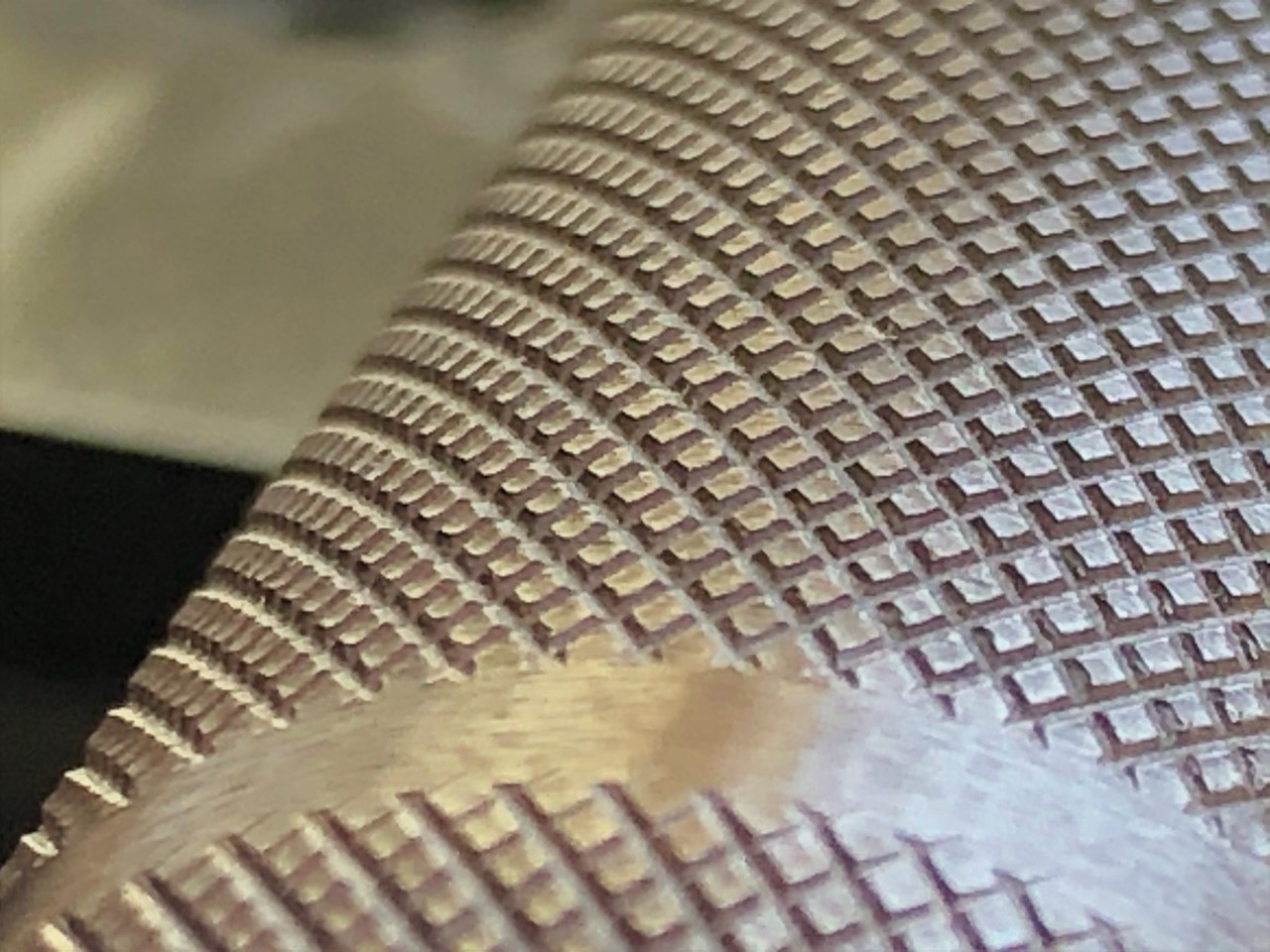
First, hills are a pattern of sloped, flat-topped diamonds. It’s the most common pattern and can be found everywhere. The cheapest bars (a cheap 7ft bar is currently around $120) always have this knurling, while many expensive bars do too, because that’s what some people want. On some bars the hills have more sloped sides, while on others they’re more like plateaus with almost vertical sides, creating a slightly better grip.
The hill pattern in the pic of the Troy bar above may look aggressive due to the camera effect, but I can tell you it feels very soft.
Hill knurl is what we call a passive knurl. It helps with your grip significantly over a smooth bar but never digs into your hands too much. It allows for grip transitions in a clean where you slide your hands to transition from pulling to pressing. It can slip out of your hands, and even more so when your palms get sweaty, leading to lifters using chalk or lifting straps with hill knurl at a lower weight than the other types of knurl.
Some popular brands of bars that use this:
[1] FringeSport and American Barbell do the hill knurling a little deeper than some other brands, so they stick to your hands a little better.
Mountain Knurl
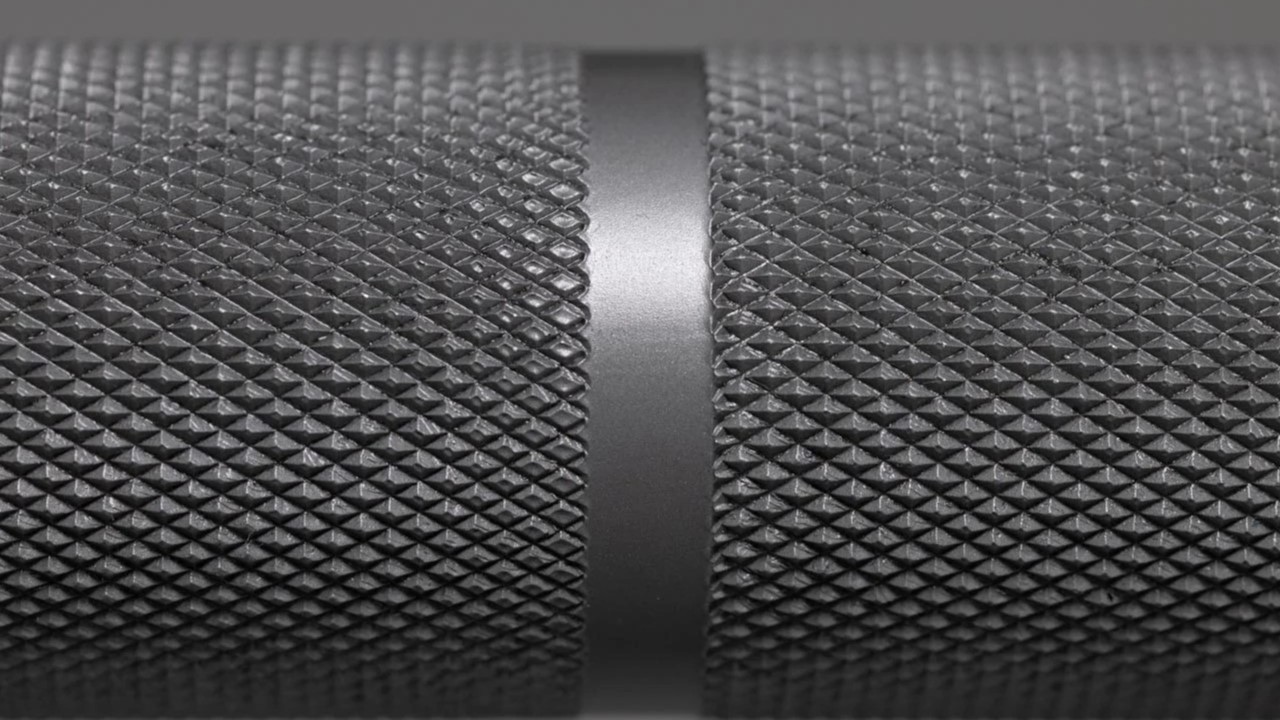
Popularized by the Texas Power Bar in the 1980s, this knurl is known to feel very aggressive. It’s also been called a pyramid knurl or “cheese grater” knurl. Each diamond comes to a sharp peak. While the flat tops of a hill knurl feel barely there at all, the deep cuts and sharp peaks of this pattern are the opposite extreme.
The peaks hold your palm in place and prevent slipping, at the cost of some discomfort with the peaks digging into your skin and likely tearing up your skin with high reps. It’s meant for doing slow, low-rep powerlifting movements where you want the bar to stick to your hand and stick to your back when doing squats. The best use cases for this are either lifters who have skin on the tougher end of the scale or heavy lifters who want to avoid the use of chalk or straps. For average lifters, mountain peak knurl can be better than hill knurl for some lifts but is not usually optimal unless the knurl is more finely cut than average, which causes it to feel more like volcano knurl further below.
One other downside to this knurl is re-centering a loaded bar on your J-cups – by trying to spin and shimmy the bar – is harder because the knurl will grip and tear up your J-cups’ UHMW liners.
Some popular brands that use this:
[2] The American Barbell and FringeSport Midas’ Revenge knurls are cut shallower and more tightly spaced than other brands, resulting in more peaks and a less aggressive feel that is more like volcano knurl (below).
Volcano Knurl
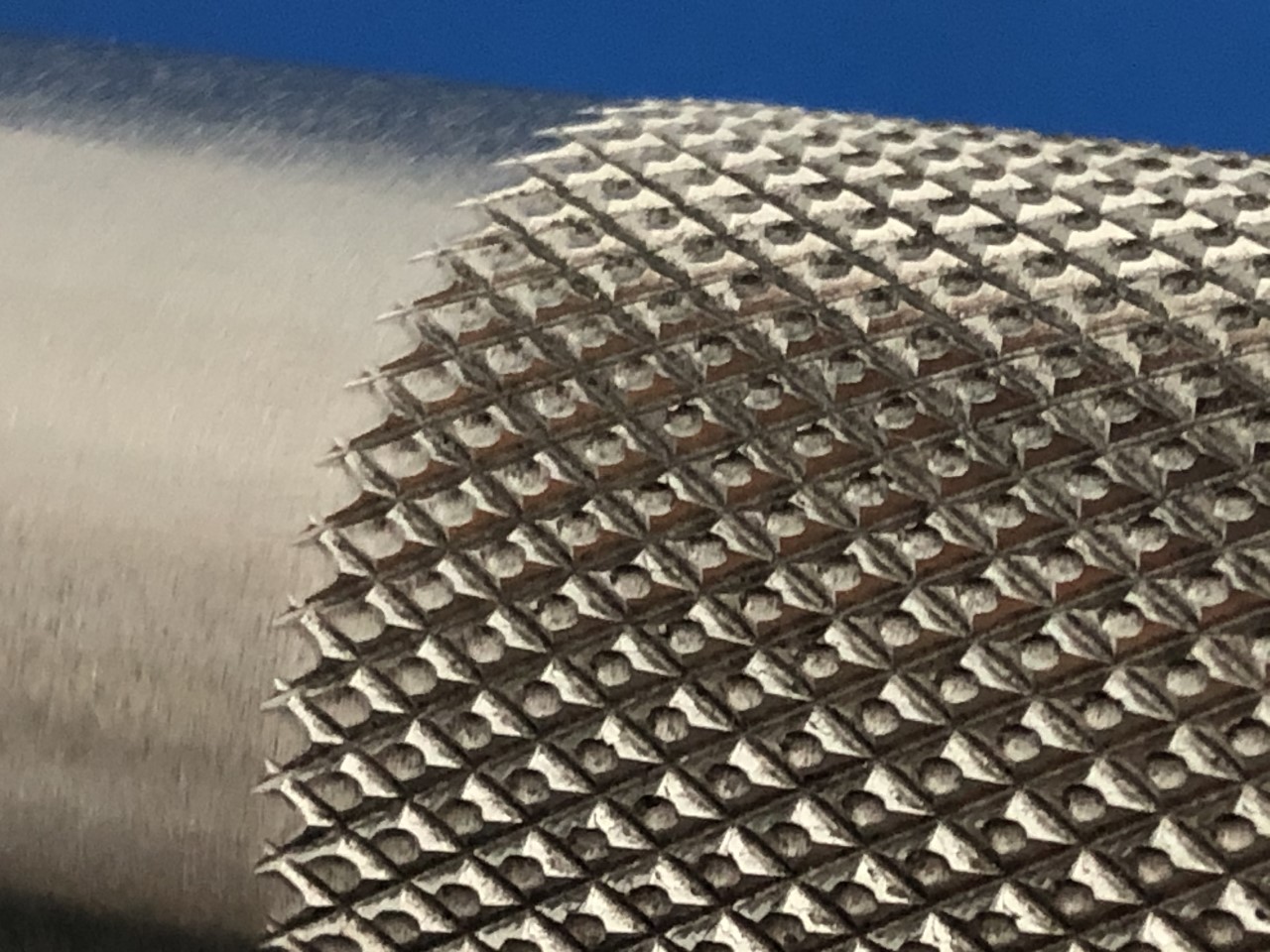
Volcano knurl consists of concave-topped hills resembling volcanos.
Why create this pattern? It creates an effect like a finely cut knurl with more mountain peaks. The roughly circular shape of each concave volcano causes each corner of the diamond to be a small peak. More peaks results in a knurl with more contact points that grab your skin better, while each peak is shallow enough that it often doesn’t feel sharp.
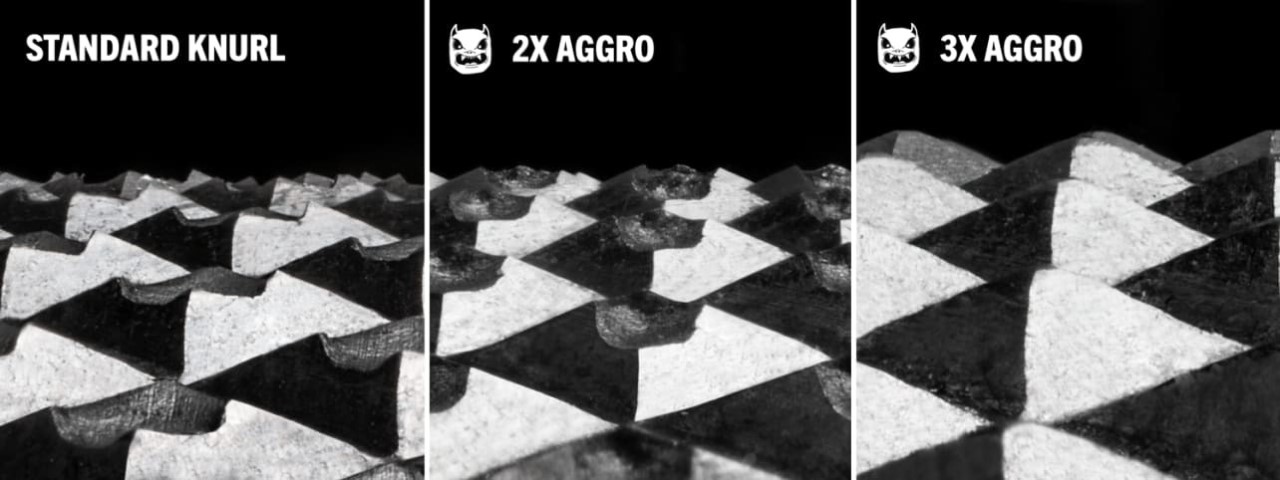
There are degrees of aggressiveness illustrated by this image from Rogue. The “standard” volcano knurl above is what you’ll find on the regular Rogue Power Bar, and a shallower version of that is on other Rogue bars. What they call the 2X AGRO is more aggressive with higher peaks, while the 3X AGRO is straight up mountain knurl.
I’m told the concavity is created in the process of cutting the knurl, pushing the sides of the mountains up to create the effect.
Here are some popular brands that use volcano knurl:
[4] Kabuki Strength does a finer volcano knurl, ie: more lines and peaks, resulting in a stickier knurl than others with volcano knurl.
[5] Uesaka, a high-end Japanese brand that provides expensive bars for IWF competitions, advertises that they hand-lathe the knurl on their bars, pressing it into the shaft, suggesting that others cut into the shaft. When you look closely (below), it’s a volcano pattern where the concavities are very wide and shallow. I believe this creates the feel of a mild volcano pattern.
[6] Eleiko’s Powerlifting bars have the most aggressive volcano knurl, followed by their Weightlifting bars, and finally their XF bars with a mild volcano knurl.
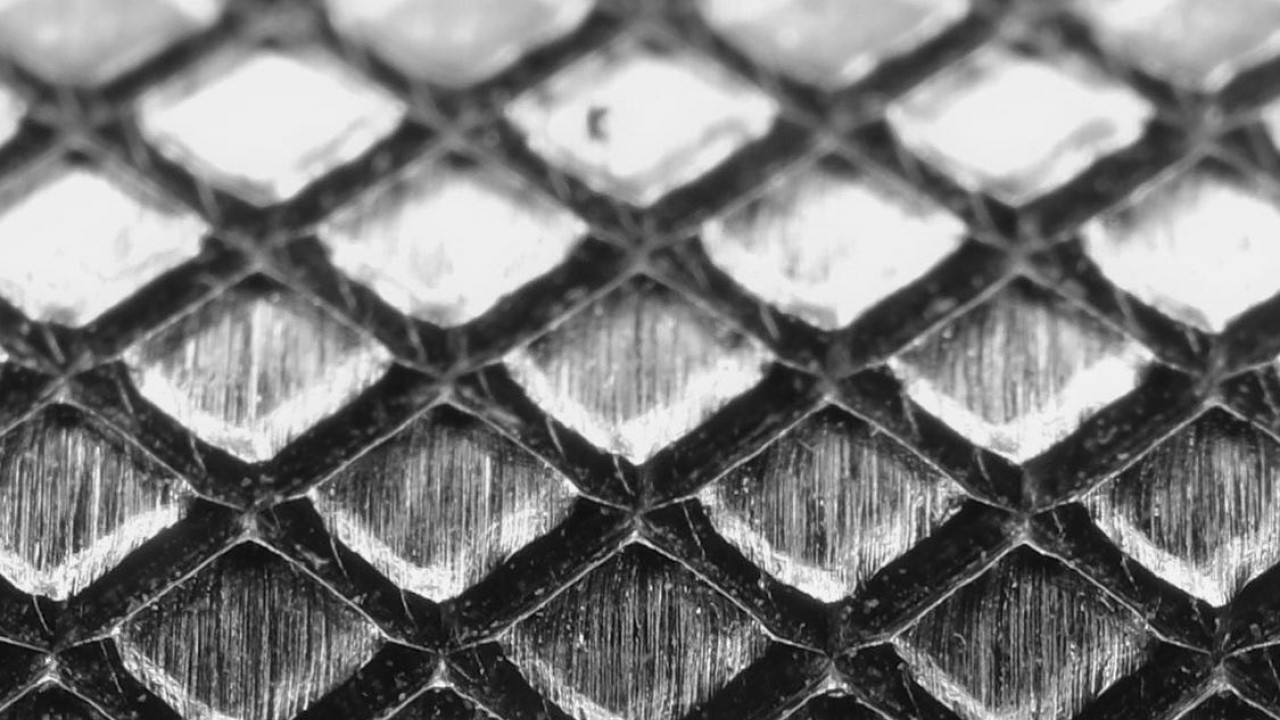
The Effect of Bar Coatings
The coatings used on bars will affect how severe the knurl feels.
Knurl will feel the most aggressive on a bare carbon steel, bare stainless steel, or black oxide coated bar. Carbon steel and black oxide require some occasional care with the aid of oil, a brush and microfiber towel to keep a thin layer of oil on it to protect against rust. Black oxide will wear off from regular use, leaving you with a bare carbon steel bar, which in either case can develop a patina coating over the years, which is a smooth, thin, inert rust that won’t get worse and actually protects the bar against active rust. Stainless steel stays in great shape for years or decades, requires little or no maintenance, and is best for humid climates, for a higher price tag.
Chrome, zinc and cerakote fill in the knurl to some degree, making it more slippery and less uncomfortable if that’s an issue. This can be a good or bad thing, depending on what you want.
Choosing the Best Knurl
A Word on Consistency
I’ll pick on Eleiko here, simply because it’s the one people have nitpicked about enough times – maybe due to Eleiko’s high prices and reputation – that it makes for a good example. Eleiko has described their process as using a new bit for knurling the competition bars, then on down to the less expensive training bars and other bars as the bit wears and can’t cut as well. But people have complained over the years that Eleiko’s knurl feels inconsistent between two bars of the same model, whether competition or training bars. I don’t know enough about the process (almost nothing, in fact) to speculate what’s going on, but it makes me wonder what other brands are doing differently to put out a consistent knurl, or if they do.
I’ve seen bars with mistakes in the knurling process, like a double pass, inconsistent feeling from one end of the shaft to the other, or a missing ring mark. People are more picky about bars nowadays, and I think these mistakes are less common to find on new bars.
For Powerlifting
Volcano is a good choice for any of the slow, controlled movements like squats, deadlifts, bench presses, and overhead presses. It sticks to your hands and back without really digging in hard. There are light and deep volcano knurls available. If you’re in doubt, give volcano a try first.
If you’ve tried deep volcano knurl and want something more extreme, a mountain knurl could be what you need. Be advised it’s only a good idea to use it for low-rep workouts, or it can start to rip at layers of your skin.
Keep in mind that aggressive knurling does not only help with pulling movements. It locks the bar in your hands better for presses too, so you can focus on pressing more weight. It’s not obvious it would help until you’ve tried it.
For Crossfit, Olympic Weightlifting, or High Rep Workouts
Anything involving sets of high reps are best done on a bar with a softer volcano knurl or any hill knurl. No matter which one you choose, your hands can still get blisters/tears from the friction heat buildup of high reps of something like cleans or snatches. At least with softer knurl you won’t be damaging your hands in the beginning of your workout.
Some bars have a softer center knurl. They will say so in the product description. That’s recommended if you’re doing cleans, and nice for sets of front squats too.
Brand Variation and Individual Taste
Not all knurls of a given pattern type are going to be the same. I have noted a few brands and models in the lists that are softer or more aggressive than typical. A power bar of any brand is generally going to have more aggressive knurl than other bars of the same brand. The same goes for a competition bar, whether for powerlifting or olympic weightlifting. A bar marketed for high-rep workouts like Crossfit will have more passive knurl to save your hands.
If you’re unsure what you’ll be getting based on a product page’s description, ask for a close-up pic of the knurl on the bar. With a good pic you can identify the flat tops, sharp peaks, or the circles each peak indicating volcano. Other than that, it’s extremely hard to identify from a pic alone how aggressive each one is compared to another of the same general knurl type. With a good focused pic at the right angle and lighting, every knurl deceptively looks brutal, whether it feels that way or not.
I have not tried every brand of bar. This year I cleared out the few bars I had in favor of the Rogue Ohio Power Bar, which has a volcano knurl on the more aggressive side. That’s all I need for now, and to me it feels great for low reps. If I wanted to do some high-rep workouts that include cleans, I’d probably get some other bar from Rogue or Rep Fitness with the less aggressive volcano knurl and no center knurl.
Ultimately this is going to come down to individual preference. These all feel different to different people who have different amounts of experience in lifting, maybe durable hands from doing a lot of manual work, different pain tolerances, or just naturally thicker or thinner skin.
If I have described any of the bars noted on this page inaccurately, please leave me a comment below and I’ll look into it!
Here’s an infographic for easy sharing:
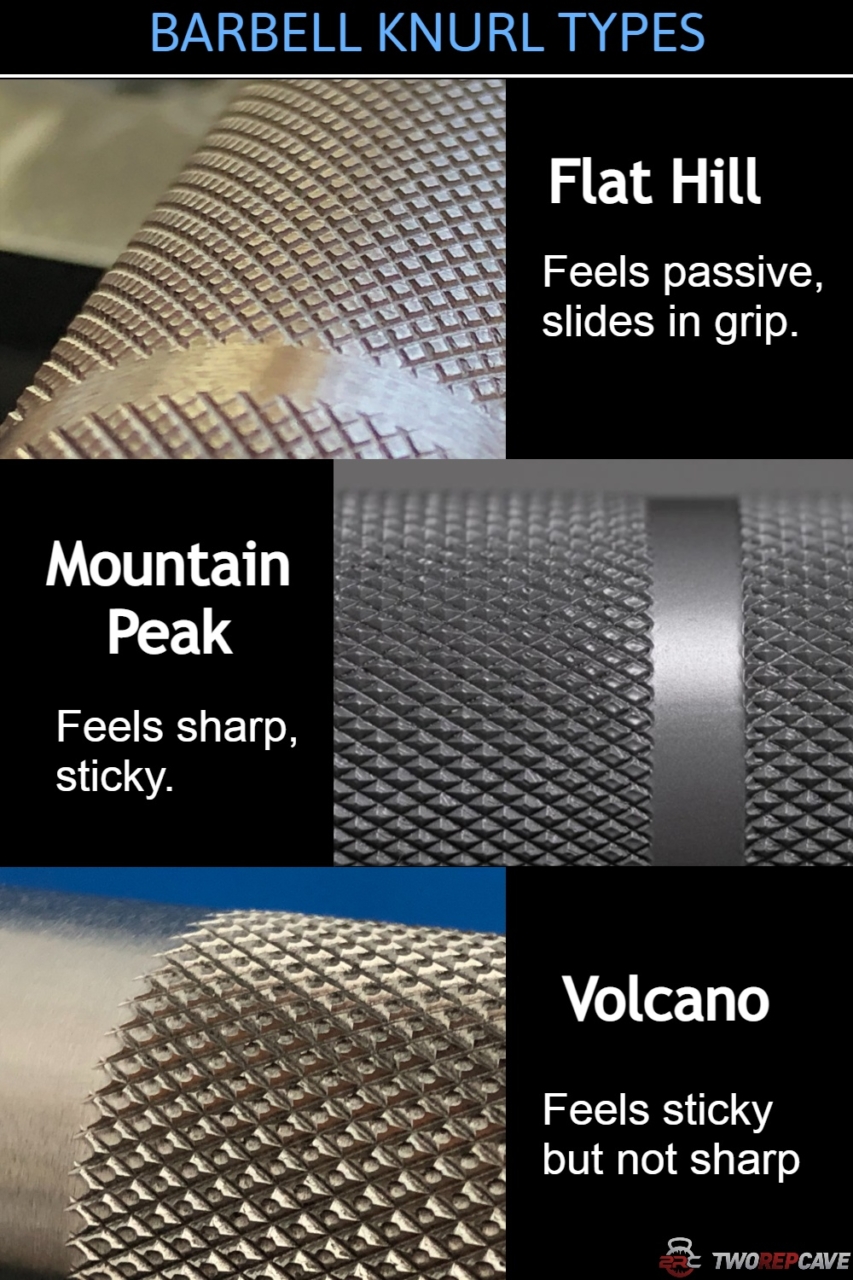

Great writeup! One other factor to consider is the point density. The founder of Ivanko points out the higher density points per inch will be by definition shorter peaks than lower points per inch (a pyramid can only be as tall as its base is wide).
Elite FTS makes a powerlifting bar with low point density akin to a cheese-grater — one rep only and then you start to bleed. I personally like Ivanko’s 28.5mm bar because I can get tolerate 8 heavy reps with their knurling (a tad more aggressive than Texas Power Bar).
With Ivanko feeling more aggressive than even a Texas Power Bar, it sounds like Ivanko doesn’t do the higher density type that the founder talks about? (also if you have a link I’d love to see everything he says) So far I know of American Barbell and Kabuki doing pretty fine (high density) cuts, but there’s probably more, and if there’s some all along that spectrum then this could get tough. Good point on the higher density also meaning shorter peaks. I didn’t think of that!